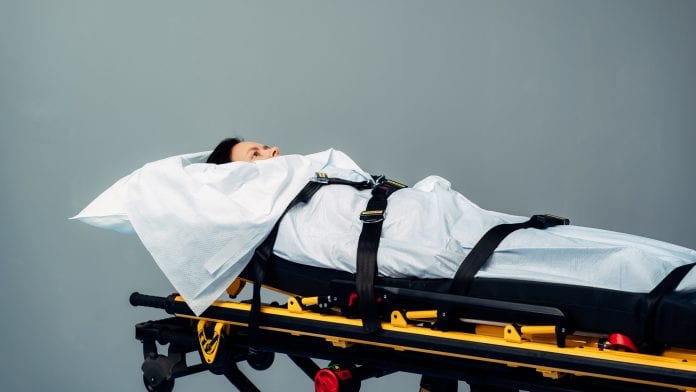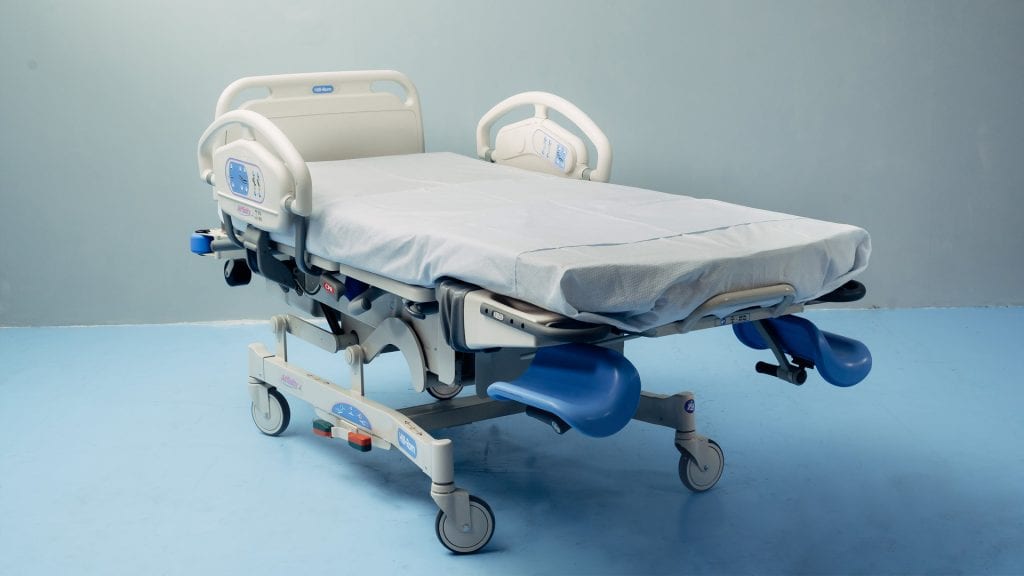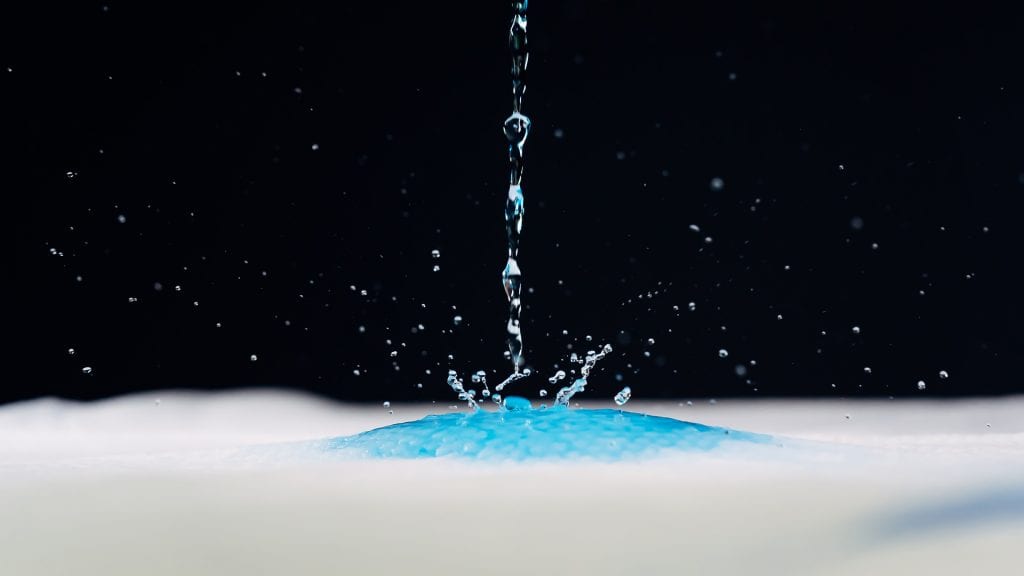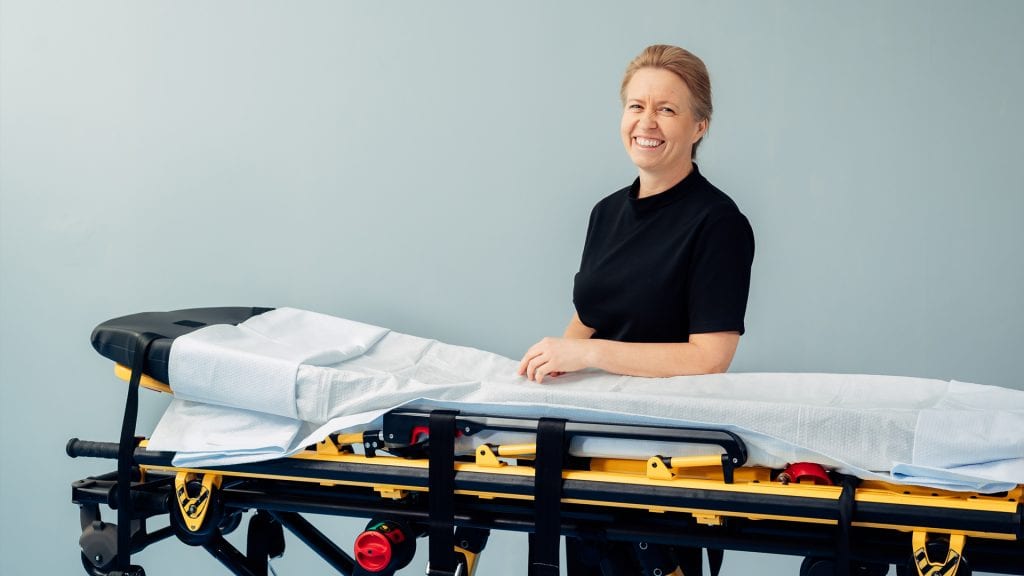
Hospital linens are a key vector in infection control: ASAP, Norway’s next-generation sheet technology, can protect both patients and staff
The COVID-19 pandemic has proven that we still need an increased and improved focus on hygiene and infection control. ASAP, Norway’s next-generation, highly-absorbent disposable sheet technology contributes to this by encapsulating liquid and moisture, while also preventing penetration and at the same time providing optimum care and comfort for the patient. All these features are combined into one product that is disposable, environmentally friendly strong enough to lift a patient. For the first time ever, ASAP Norway’s products are available on the UK market via Amazon. Our focus areas primarily apply to ambulances and emergency areas, wards, and maternity wards.
Can we afford innovation?
Let us say you have a marvellous idea. It is going to change the way we have usually done things. Maybe your idea challenges the traditional way of listening to music? Maybe it will be a revolutionary transportation method? However, while your idea will make life easier and more efficient, it will in all honesty be exceedingly difficult to sell.
It is the year of 1839 in the US state of Philadelphia. The civil engineer and inventor William Otis has just been issued a US patent for his newest invention, the steam shovel (1). This is believed to be the world’s first excavator; and it might be reasonable to believe that people would be overjoyed that their job would become easier and more cost-efficient for the entire construction industry. In fact, it took four years before the steam shovel was deployed on its first major job, digging the Welland Canal in 1843. Dozens of men were displaced; and labourers grew so angry that the company had to post guards on the site to protect the machine. (2) The shovel was a major investment and more effective, but if dozens of men lost their income and could not feed their families, would it be worth it? The idea was good, but innovation changes the way we do things, turns processes upside down and changes lives. It is not difficult to understand that William Otis died before he managed to sell his first steam shovel.
Innovation is about daring to bet on what you believe in. It is also costly in terms of time and resources; and, for most ideas, a doomed mission: around 90% of start-ups fail within five years. ASAP Norway believes that successful innovation must be integrated into everyday life. It is about waking up every day, making the right decisions at the right time and working hard and smart with lots of patience. Even with all these factors in play, a decent amount of luck is still necessary to succeed.

Our background
Arriving at the hospital, Astrid Skreosen went straight to the maternity ward. Astrid, a mother of four, had been working three jobs for years to get a full-time position here. Being an auxiliary nurse during births was a busy job and she loved it. The role primarily consisted of doing what the doctors, midwives and nurses did not have the time to do; it was about running errands for the woman in labour to make them feel as comfortable as possible. After every birth it was Skreosen’s job to make sure everything was shipshape before the next one. However, that part of the role ended up becoming so frustrating that she quit her dream job after 15 years at the hospital. What made her take this crucial step?
For auxiliary nurses in the maternity department, the cleanup process after a birth comprises sizeable amounts of blood, liquids and other spills. The birthing bed consists of three separate parts which can be moved and adjusted according to the needs of each birth, meaning there are innumerable nooks and crannies for these liquids to hide. In addition to the spill issues, the sheets on a birthing bed were not fitted: no hospital sheets were designed or made to fit a birthing bed. An energetic birth would cause sheets to move around, while absorbent pads would become displaced and lose their purpose. For hygienic purposes, therefore, the birthing bed would have to be sent for cleaning after each birth, which is a very costly and lengthy process.
Was there no better alternative on the market than cotton sheets and tiny plastic pads for a birthing bed? Since there was no solution available, Skreosen – the founder and CEO of ASAP Norway – quit her job, determined to produce a better solution herself.
Skreosen knew that her new idea could possibly revolutionise the industry. It would need four key features in order to improve on the previous solution:
- The product would need to stay properly in place, no matter how much the patient turned and kicked. This was resolved by attaching adhesive tape to the sheet;
- The product had to be resource-efficient: there is already enough waste after a birth, so no need to add more into the pile. Using three components – bioplastics, superabsorbent polymer (SAP), and non-woven material – the finished sheet would be 0.7mm thin;
- There had to be an easier way to measure blood loss during a birth, as this information is crucial to provide the right help for both mother and child. The sheet’s design enables healthcare practitioners to create a ‘bag’ at the end of the bed: not only would this make it easy to measure blood loss, but it would also be a great deal more hygienic and efficient, as all waste could be easily collected into the bag, making the cleanup process after a birth much easier; and
- The sheet had to be made from strong, sustainable materials and be sufficiently robust to lift a patient from one bed to another. The materials used in the sheet enable it to lift up to 200kg.
A better all-in-one solution would be hard to find. It would make the everyday life of so many hospital staff easier and more efficient, leaving healthcare professionals with more valuable time for caring. The product would be biodegradable and fulfil all known requirements for being environmentally friendly. Talk about saying hello to the future!

Disposable sheets in healthcare
The use of disposable linens in healthcare settings is not a new concept, although admittedly demand has surged in the face of the global coronavirus pandemic. Traditional gowns, undersheets and drapes were initially made of cotton, before the development of paper-based and more tightly woven fabrics with fluid-repellent treatments. While some of these new woven materials had become more advanced and durable by the 1970s, (3) the associated hygiene issues began to be recognised with the spread of nosocomial pathologies. (4)
Research and technological innovation began to focus strongly on substituting these traditional linens with disposable materials. In the process of developing disposable bed linen, researchers and manufacturers have used a wide range of materials from virgin wood pulp and recycled cellulose, to polypropylene and polyethylene derived from fossil oils, to Tencel fibres made from eucalyptus trees. Most of these materials have been developed to be highly absorbent, while balancing the need for liquid and microbial barrier properties with the requirement of being soft and comfortable.
Of course, the environmental and economic impact of single use products has long been a source of debate, with concerns regarding disposal of contaminated medical waste.5,6 While biological protection is essential in a healthcare setting, it has become apparent that minimising environmental impact is a key area of concern. Some materials have been developed to be biodegradable in order to minimise bio-accumulation and toxicity to the environment, while some now aim to use recycled or sustainable materials. These properties appeal to the more environmentally conscious ethos present both in healthcare procurement and amongst the wider population.
Despite the debate, single-use disposable linens have become an everyday healthcare consumable found on the majority of wards, emergency departments, health centres, ambulance and domiciliary care providers. ASAP Norway is certainly making its mark when it comes to sustainable innovation and offering the healthcare worker a lighter ecological footprint.
COVID-19 and the use of infection control and cleaning standards in healthcare settings
In light of the infectious nature of the COVID-19 virus, extensive protocols have been developed all over the world for the safe management of infection prevention and control. The demand for disposable medical textiles has rocketed, with the understanding that for patients who are suspected or confirmed to be COVID-19 positive, the use of disposable linen and textiles should always be considered.
This was backed up by guidance produced by Public Health England and the NHS in the United Kingdom. They outline the advised standards of environmental cleaning and disinfection, with the recommendation that dedicated or disposable equipment is used. Specifically in the safe management of the healthcare environment where blood and body fluid contamination risk is high, patient care equipment should be single-use where practicable. (7)
Prior to the pandemic, all healthcare workers will have been familiar with wearing personal protective equipment (PPE) when in contact with patients to minimise the transmission of transferrable diseases, as well as the use of protective textiles, undersheets and linens. These measures were already in place in the background of healthcare, but the focus has now shifted and they have emerged into the forefront of what is expected from a safe and sanitary care environment.
The focus is also very much on understanding that protective equipment and materials are employed for the benefit of the patient, but also for the health, safety and protection of the healthcare provider. ASAP Norway offers a hygienic and convenient option for both patients and clinical staff.
It is important to acknowledge that, for the patient, the use of disposable sheets can impact on their comfort and dignity, as they are often used in situations which require sensitivity and compassion. When a product like ASAP Norway’s has the potential for skin-to-skin contact, the product should feel clean, comfortable and soft. From a clinical point of view, ASAP Norway’s disposable sheets play a role in protecting laundry, clothing, furniture and equipment, by minimising cross-contamination and the bioburden of the care environment.

COVID-19 and use of disposable products
The are many advantages of disposable medical materials and textiles, such as the products created by ASAP Norway. As mentioned, they play a role in the protection of equipment and bedding, as well as assisting in infection control and minimising cross-contamination.
In these roles, ASAP Norway’s products are not only at the forefront of COVID-19 management: they also have an established market in healthcare areas like obstetrics, surgery, recovery and critical care, emergency and outpatient care, as well as in ambulances and in community settings. They offer a convenient and time efficient option for busy, overstretched staff to set up and clean up after procedures where fluid contamination is likely, to help them deal with spills quickly and effectively and make bedding and laundry changes with ease.
For the patient and their families or carers, there is the comforting reassurance of feeling protected by a product which promotes their safety and dignity. ASAP Norway’s product is highly absorbent, keeping the patient’s skin drier and more comfortable to the touch. It is also easily changed and disposed of when required, minimising disruption and discomfort and promoting a high level of infection prevention and control. (8) The multipurpose aspect of the product means it can easily be employed in the clinical or care setting, whether that be at home or in a hospital, health centre or nursing home.
On understanding and dealing with the fears of healthcare providers and patients regarding the COVID-19 pandemic, the ability to treat patients with products that have not been used by anybody else promotes a very high degree of confidence. Exemplary levels of cleanliness and hygiene are actively being sought by healthcare providers as well as the general population in the fight again coronavirus. It has been shown that this image of cleanliness and hygiene is essential from an infection control point of view to minimise cross-contamination, and is psychologically important to both healthcare workers and patients. (1)
It is clear that ASAP Norway’s products have taken on board these factors when it comes to meeting the needs of healthcare, both in general and during a global pandemic.
References
1) Wikipedia. https://en.wikipedia.org/wiki/William_Otis Accessed 15/12/2018.
2) JR Chiles, 2010. https://www.inventionandtech.com/content/steam-shovel. Accessed 15/12/2018.
3) G Sun. Disposable and reusable medical textiles. Textiles for Hygiene and Infection Control 2011 2014 Mar: 125-235.
4) C Signorelli et al. Problems of laundry hygiene. Annals of Hygiene 1989 Jan; (1-2): 81-6.
5) R Newton et al. Reusables vs. Disposables. Health Care (Don Mills) 1984 Mar; 26(2): 24-5.
6) H Zins. Product issues related to reusable healthcare textiles. Research Journal of Textile and Apparel 2006; 10(4): 73.
7) Public Health England, August 2020. COVID-19: guidance for the remobilisation of services within health and care settings. Infection prevention and control recommendations. https://assets.publishing.service.gov.uk/government/uploads/system/uploads/attachment_data/file/910885/COVID-19_Infection_prevention_and_control_guidance_FINAL_PDF_20082020.pdf. Viewed 11/11/2020.
8) NHS Business Services Authority and NHS Clinical Evaluation Team, September 2017. Clinical review: procedural underpads. https://www.nhsbsa.nhs.uk/sites/default/files/2017-09/Clinical%20review%20-%20Procedure%20underpads%20%28V2%29%2009.2017.pdf. Viewed 11/11/2020.
Elena Skreosen
ASAP Norway
elena@asap-norway.no
https://asap-norway.no/en
This article is from issue 16 of Health Europa. Click here to get your free subscription today.








